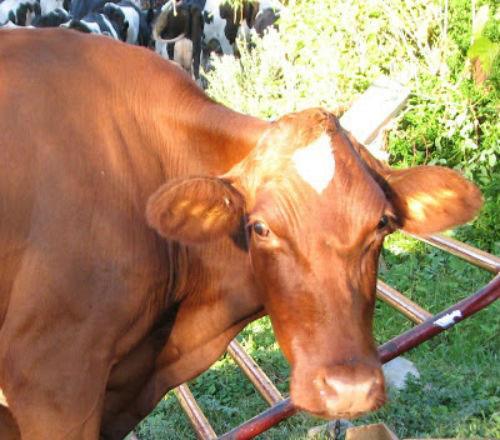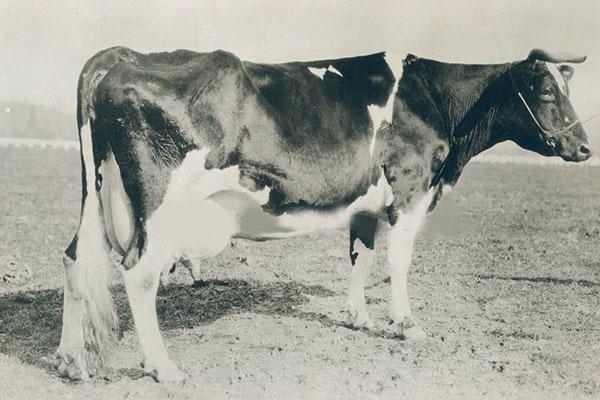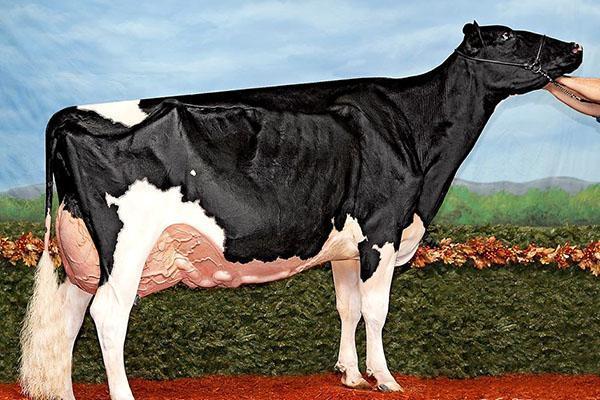Dairy cows and Skittles candies
 When, for unknown reasons, one of the Wisconsin highways turned into a road strewn with thousands of Skittles sweets, it sparked an outcry over the feeding of sweets, bread and cookies to cattle. I believe that some light should be shed on this question.
When, for unknown reasons, one of the Wisconsin highways turned into a road strewn with thousands of Skittles sweets, it sparked an outcry over the feeding of sweets, bread and cookies to cattle. I believe that some light should be shed on this question.
Modern dairy cows have been specially bred to produce massive amounts of milk with proper care. Such care is one of the key tasks of agriculture. For reasons of economy, a farmer wants a cow that produces more milk with less water and feed, and occupies fewer acres of land.
In the photo below you can see what a Holstein cow looked like in the 30s:
And what it looks like now:
I understand that most people do not rate cows according to Dairy Judging criteria and are probably bred for milk or for display. However, even with the naked eye, you can see the obvious difference between the two examples. Although cow "A" was good at one time, but today she can no longer compete with modern individuals in the amount of milk.
Now take a look at cow "B". These strong, powerful legs, wide chest, straight back, and these veins ... It is not for nothing that they are called milk veins. The udder is raised high and snug against the cow's body, which is an important factor affecting life expectancy.
Of course, the second cow is a champion by all accounts, but you can see how much the breed has evolved over the years.
As much as the animal has changed, so has the approach to feeding it. Now this is a real science, and quite complex.
When farmers add candy, cookies or cakes to their cow's diet, they do so under the strict supervision of a trained nutritionist. Experts select the optimal ratio of elements such as sugar, starch and protein to maximize the benefits for the animal, while reducing feed costs.
The needs and digestive system of a cow are fundamentally different from those of humans. When we attended meetings about proper cattle feeding, nutritionists and veterinarians talked about how by feeding the cow you are actually feeding the bacteria inside it.
Such bacteria are found in the rumen and break down food into its constituent elements. This process is fundamentally different from what happens in the human body. Thanks to this arrangement of the stomach, the cow is able to turn the eaten grass into meat and milk. We, on the other hand, would receive nothing from such food, except pain in the stomach.
The sugar in the candy can help the cow get the nutrients she needs in the right amount, improving the overall well-being of the animal. This fact is confirmed by practical examples.
We have worked with professional dietitians from both our feed suppliers and independent companies. We've also consulted with a group of cattle veterinarians, and these people really know their stuff. I have personally attended many meetings and trainings dedicated to all aspects of cow management, from caring for them to recommendations for optimal feeding.
 In the past, we tried to feed the cows with cereals, adding to them the chocolate left over from the production of people. By the way, the smell in the barn has definitely improved.We've also tried adding a range of foods to the diet that you can't find in the field: citrus pulp (another good option for odor-improving stalls), cottonseed meal, and other by-products from food production. Pat, Jim, Chris and many others have taught us how to use these ingredients correctly. The world-renowned Cornell Cooperative Extension has partnered with veterinarians and feed companies to develop many nutritional education programs for cattle.
In the past, we tried to feed the cows with cereals, adding to them the chocolate left over from the production of people. By the way, the smell in the barn has definitely improved.We've also tried adding a range of foods to the diet that you can't find in the field: citrus pulp (another good option for odor-improving stalls), cottonseed meal, and other by-products from food production. Pat, Jim, Chris and many others have taught us how to use these ingredients correctly. The world-renowned Cornell Cooperative Extension has partnered with veterinarians and feed companies to develop many nutritional education programs for cattle.
 So you can see for yourself that criticizing farmers for adding Skittles to cows' diets is unfair. You just have to study a few examples of the modern dairy cow's menu, and you will see how carefully it is composed.
So you can see for yourself that criticizing farmers for adding Skittles to cows' diets is unfair. You just have to study a few examples of the modern dairy cow's menu, and you will see how carefully it is composed.
 A huge amount of food produced for our pleasure is thrown away and wasted. So why not partly use some of the mass-produced leftovers that would go to landfill anyway to be converted into nutritious food for livestock? Isn't this approach one of the ways of sustainable development of society?
A huge amount of food produced for our pleasure is thrown away and wasted. So why not partly use some of the mass-produced leftovers that would go to landfill anyway to be converted into nutritious food for livestock? Isn't this approach one of the ways of sustainable development of society?